Smoke Testing: A Comprehensive Guide to Early Defect Detection
Pritpal Singh
May 5, 2025
Did you know the software development industry hit the 45 billion mark in 2024? With customers demanding smooth functioning and excellent app performance at all times, high-quality software is a necessity. While businesses have used the best manual and automated methods to ensure seamless performance, the key lies in mastering the basics. And what does that mean?
We are talking about smoke testing, which can help you find defects in the application at earlier stages and save the time of QA (Quality Assurance) teams. This is all the more essential, as fixing defects after release can be 30 times more costly than addressing issues after the implementation stage. There is much more to smoke testing; we will explore all the aspects in this blog.
What is Smoke Testing?
Smoke testing is a software testing method in which the most critical and fundamental application features are tested to ensure smooth working. It is a preliminary health check, and “Smoke” comes from hardware testing.
Earlier engineers would power up a device if it didn’t emit smoke; it was said to have passed its first basic test. However, smoke testing cannot be considered one-and-done as it doesn’t deep-test all features.
You should use it only to ensure that core functionality is in place and no significant issues would prevent further testing. Testers or developers can perform these tests, and once they are performed, they are sent to the QA team for additional tests.
Here are some of the parameters that are checked during a smoke test.
- A responsive user interface is a customer’s basic demand. So, developers run a smoke test to ensure it works as expected and addresses bugs.
- It doesn’t matter if the site has been developed aesthetically or if essential functions like login features, screen navigations, and submission forms are not working perfectly. A smoke test rules out any issue with these aspects.
- The next check is to see if essential workflows are being efficiently executed. If users can search for products on your site, add them to their carts, and purchase them with zero hassle, then the smoke test is considered successful.
Now that you understand the basic parameters, you need to know the situations in which smoke testing is performed.
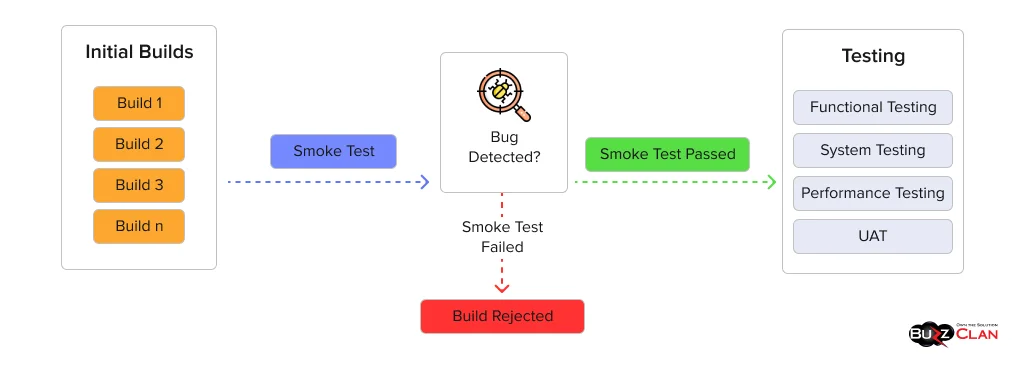
- Post-Launching New Application Versions (Build): After developers have fixed defects or added features, you should run a smoke test on the updated version to check for issues.
- Post Deployment: If the software is deployed on a test or production server, smoke testing is used to check that the deployment was a hit or a miss
- After Integration: If multiple teams have worked on the software, smoke testing will help confirm whether all pieces work together.
Smoke Testing Examples
Here is how you can check some of the basic features of a build with scripts.
Verifying Successful Application Launch
This is to check if an application can launch quickly with zero errors.
python
from selenium import webdriver
# Launch the browser and open the URL
driver = webdriver.Chrome()
driver.get ('http://your-web-application-url.com')
# Verify that the page title is correct (basic check)
assert "Expected Title" in driver.title
# Close the browser
driver.quit()
Login Functionality Test
This test will help you check if users can log in with valid credentials.
from selenium import webdriver
from selenium.webdriver.common.by import By
from selenium.webdriver.common.keys import Keys|
driver = webdriver.Chrome()
driver.get ("http://your-web-application-url.com")
#Locate the Login fields and button
username = driver. find_element(By.ID, "username")
password = driver. find_element(By.ID, "password")
login_button = driver.find_element(By.ID, "loginButton")
# Perform Login with valid credentials
username.send_keys("validUser")
password.send_keys("validPassword")
login_button.click()
# Verify if Login was successful by checking the URL or a successful login message
assert "dashboard" in driver.current_url
driver.quit()
Check For Form Submissions
This script lets you check if a form works in the desired manner if basic inputs are given.
from selenium import webdriver
from selenium.webdriver.common.by import By
driver = webdriver.Chrome ()
driver.get ( ‘http://your-web-application-url.com/contact’)
# Locate form elements and fill them out
name_field = driver.find_element (By.ID, 'name')
email_field = driver.find_element (By.ID, 'email')
message_field = driver.find_element (By.ID, ‘message’)
submit_button = driver.find_element (By.ID, 'submit')
name_field.send_keys ( 'John Doe')
email_field.send_keys ( ‘john.doe@example.com' )
message_field.send_keys ( ‘This is a test message.')
# Submit the form
submit_button.click ( )
# Verify that form submission was successful (e.g., check for a success message)
assert "Thank you for your message" in driver.page_source
driver.quit()
Verify Page Load Time
This will help you check if a page loads correctly in minimal time.
import requests
url = 'http://your-web-application-ur1.com'
# Send a GET request and measure the response time
response = requests.get(url)
# Check if the page loads successfully within 2 seconds
assert response. status_code == 200
assert response.elapsed.total_seconds( ) < 2 # Less than 2 seconds for example
Basic Navigation Check
This is to check if users can navigate your website with ease.
from selenium import webdriver
from selenium.webdriver.common.by import By
driver = webdriver.Chrome()
driver.get ('http://your-web-application-url.com’)
# Navigate to a different page via a navigation menu link
menu _link = driver. find_element(By.ID, 'aboutUsLink')
menu_link.click()
# Verify if the page navigation was successful
assert "About Us" in driver.title
driver. quit()
What is The Purpose of Smoke Testing?
The primary purpose behind smoke testing is to ensure the application version is ideal for further testing. For any reason, if you decide to leave it for a later stage, you are setting yourself up for frequent app crashes and failures. Thus, it is always better to spare some time, do a smoke test, and ask developers to fix these issues. Even if the developers cannot resolve these issues, your team will save time not working on a defective application.
Let’s understand it with an example of a weather application.
Testers need to check if:
- The home screen loads correctly
- City searches can be performed
- The right temperature comes for the specific city
Even if a task fails, the app is not ready for detailed testing. However, if the smoke test was successful, you can verify whether the app’s speed is optimum and whether the notifications are working correctly.
Different Types of Smoke Testing
While the purpose of smoke testing is straightforward, you can conduct a smoke test in multiple ways.
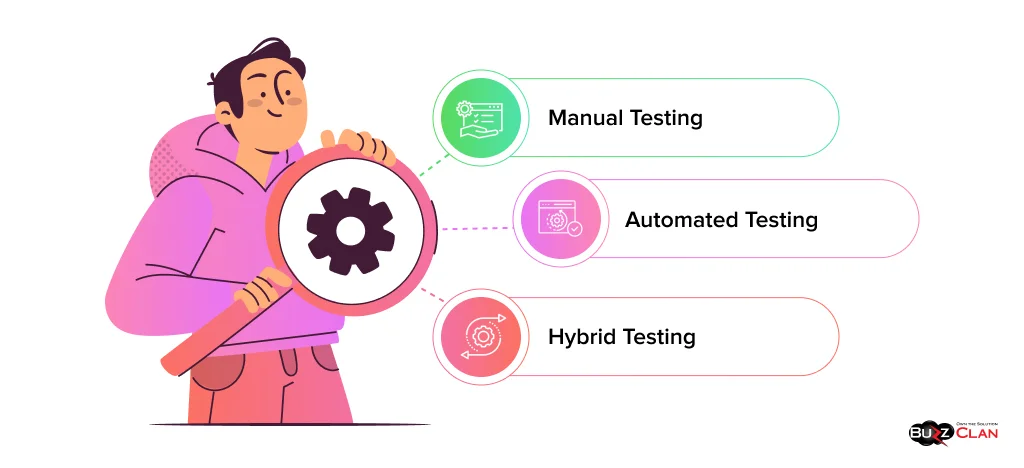
Manual Testing
Manual testing is usually done for small projects with no automated scripts. Testers or developers do it, and human intelligence forms the basis of such tests. While flexible, it requires a lot of time, resources, and energy, and a tester needs to put dedicated effort into it.
Automated Testing
Such tests use automated scripts or tools to conduct smoke tests and are ideal for Continuous Integration/Continuous Deployment (CI/CD) pipelines. The best thing about using these tools is that you can say goodbye to human errors, save time, and run these on multiple environments. However, these tests lack the human touch and don’t do justice to the experience required for application testing.
Hybrid Testing
Hybrid testing is ideal for conducting smoke tests as it combines the best of both worlds. While some cycles of smoke testing are completed using automated scripts, others are checked by a tester. This leaves no room for error; if the build is deemed fit, it can be sent further for testing. This method not only helps you save time and costs, but it also guarantees the best results.
Further Reading
Advantages and Disadvantages of Smoke Testing
While smoke testing is cost-effective and quick, there are better options for deeper testing. It should only be considered an initial step to avoid efforts in the later stage. Let’s understand the different advantages and disadvantages of smoke testing.
| Parameter | Advantage | Disadvantage |
|---|---|---|
| Purpose | Smoke testing ensures that the build is stable before further testing. | It cannot replace system or regression testing. |
| Speed | It is faster as it focuses on key functionalities. | It may overlook issues that only detailed tests can identify. |
| Cost-Savings | Businesses will save time and resources by identifying critical issues early. | It is not a comprehensive test; other tests must be performed. |
| Automation Suitability | Smoke testing can easily be automated, which makes it efficient and repeatable. | However, upfront effort is required to develop and maintain automation scripts for smoke tests. |
| Integration Testing | It helps ensure seamless integration of modules at all levels. | However, it may fail to recognize subtle integration issues often detected with more profound testing methods. |
| Simplicity | These tests are easier to execute and can be done by junior testers or even automated. | Limited scope means they could be better for testing complex workflows or edge cases. |
Why is Smoke Testing the First Step in Software Delivery?
Tell us something which you would choose:
- Solving issues one by one
- Dealing with a heap of problems that leave you frustrated.
We are sure you would choose the first option.
Similar is the case with smoke testing. There is no point in running in-depth tests on an application if it fails basic tests. Fixing errors at this stage will lead to unnecessary delays and extend the testing process. Smoke tests help developers fix the issues faster as they get quick feedback. This, in turn, ensures superior software quality.
The Impact of Smoke Testing on Software Delivery
Smoke testing is a no-brainer when it comes to boosting the quality of your software. Knowing that your designed application is robust and can satisfy customer needs, you can focus on other needs.
Early Defect Detection
What if you could save time at later stages and be aware of issues earlier? Well, smoke testing helps you do that and much more. As you will be aware of the defects in the earlier stages, you can save time by not working on unstable builds. Since the bugs are identified beforehand, they will be easier to debug and only save you time.
Streamlined Release Cycles
Let’s be honest. Your developers and testers have multiple projects to handle. With smoke testing, only good-quality application versions are sent further. When you catch issues early, you can easily keep projects on track and pave the way for more predictable and consistent release timelines.
Improved Team Collaboration
Reworks and frequent issues in application versions can lead to friction between teams. Smoke testing is a great way to clarify whether a build is ready for further testing. With smoke testing, teams can focus on problem-solving rather than fixing issues here and there.
Risk Mitigation
Customers want applications that work seamlessly and are easier to navigate and use. Smoke tests help you ensure that all critical components and functions work and deliver only the best products to your customers. Moreover, this will also build trust with stakeholders and massively improve user experience, as a stable release leads to minimal production issues.
Integration with CI/CD Pipelines
Have you ever thought about expediting software delivery through automated validation? Smoke testing has a significant role as it helps you act as a quality enhancer for automated builds and deployments. You must use it to deliver stable and working solutions continuously. Also, when you run automated smoke tests after each release, you will have fewer issues in the production stage.
Cost-Effectiveness
Did you know fixing critical issues early is cheaper than addressing them in the production stages? This means another reason to conduct smoke tests! Make it a point to run them after all builds are released and when you make changes to your application.
Smoke Testing Cycle- Step-By-Step Process
Following these steps when you run a smoke testing cycle will help you get the best results.
Choose A Test Type
Before you run a test, make sure you have your resources ready. If you run a manual test, your testers/developers must have ample time; also, if you plan on automated or hybrid tests, you should have your scripts or tools ready.
List Test Scenarios
You must decide how many tests will be conducted and jot them down. After that, you should ideate on test scenarios and their associated functionalities. Once you have done that, develop guidelines with your developers and testers to ensure test consistency and synchronization.
Create and Run Tests
Once you have everything in place, create a test with the essential features. Then, run the test and record the results to see if there are any defects.
Analyze The Results
The results of a smoke test are either Pass or Fail. If the test fails, send it to the developers again to fix issues. Once the issues have been resolved, test again to see if any problems have come up. Repeat the process till there are zero defects.
Transform your Business With BuzzClan’s Quality Assurance Services
Smoke testing is a must for all your software development needs. However, the requirement doesn’t end here. You must run in-depth tests to deliver only the best solutions to your customers. We understand and have designed the best processes and techniques to offer top-notch quality assurance services. We first understand your requirements and then create a detailed test plan. This helps us maintain transparent communication and build trust with our customers. We enjoy clients’ trust across continents due to our top-notch technical expertise and business acumen. We specialize in
- Automated compliance monitoring
- A promise of 99.99% guaranteed uptime
- 24/7 threat detection and response
- AI-powered monitoring and analytics
- Comprehensive support for multiple testing frameworks and tools.
- Improved system performance with early defect detection
Containerized Testing Environments in Smoke Testing
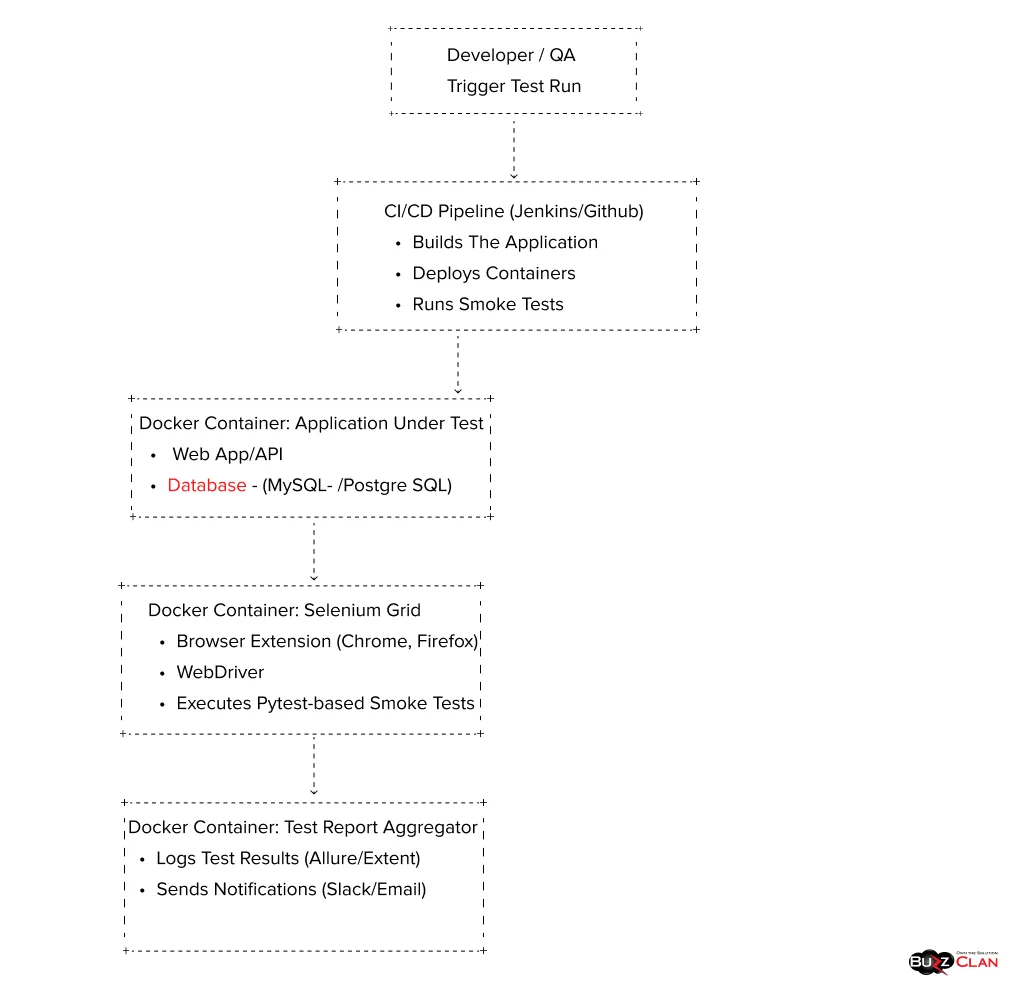
Let us understand how containerized testing environments can aid your smoke testing efforts. Initially, you can experience greater consistency, rapid deployment, and scalability. This is possible as containers take care of all application dependencies, which lets you ensure your test environment is the same as the production environment. With this, you can quickly validate your code changes in an isolated environment and boost software quality. To go further, tools like Kubernetes can be used to automate tests across multiple services. This way, you will be able to detect issues better. Last but not least, with containers, you get access to clean environments for all your tests. This way, the leftover artifacts have no impact on your test results.
Microservices Considerations in Smoke Testing
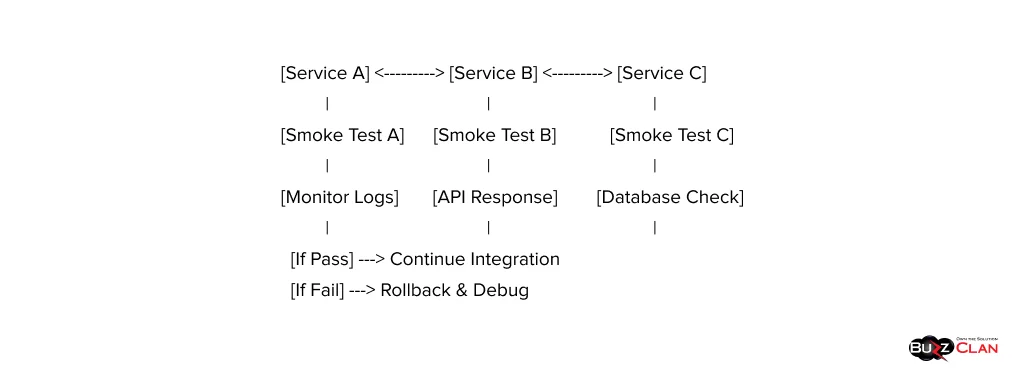
Microservices can add to the complexities in smoke testing as they rely on multiple interdependent services. You must validate all dependencies to ensure your smoke testing efforts are perfect. This means your testers will need to check if the versions are compatible, if there is minimal lag in the network, and if there are any service failures to be considered. However, if microservices must be a part of your operations, then you need to adopt techniques like contract testing and API health checks. Also, containerized environments boost microservices testing efforts by letting you validate services before full integration, thus reducing the risk of failures in production.
Cloud-Native Testing Considerations in Smoke Testing
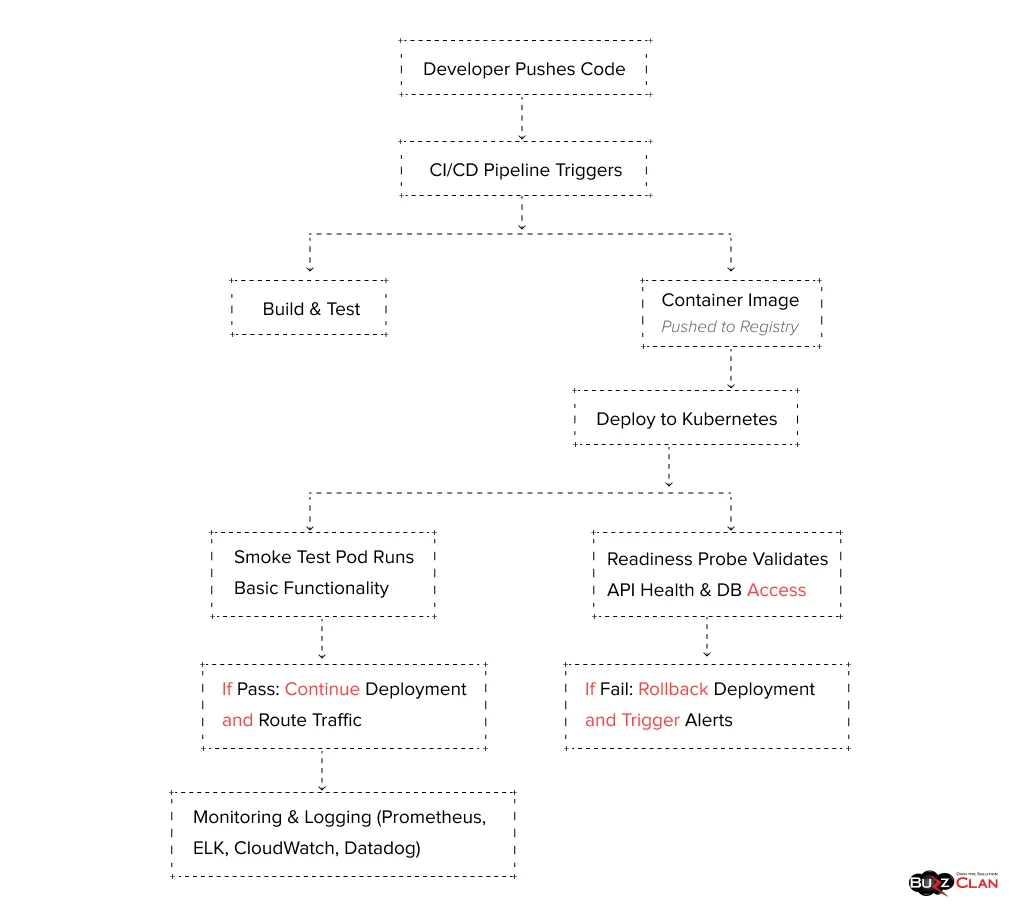
Cloud-native applications are a unique blend of microservices and serverless architectures. Thus, since these environments are dynamic, they require you to implement specific smoke testing strategies. They can easily be deployed across multiple regions, interact with third-party APIs, and scale up/down as per demand. However, the catch is that all these aspects must be validated, and minimum latency must be ensured. Since containers and serverless functions are short-lived, building persistent test environments becomes tough. Businesses use Infrastructure as Code (IaC) to provide identical and temporary test environments before conducting smoke tests. Moreover, you must also use monitoring tools like AWS CloudWatch and Azure Monitor to ensure rapid detection of failed smoke tests before full-scale deployment.
DevOps Integration Patterns in Smoke Testing
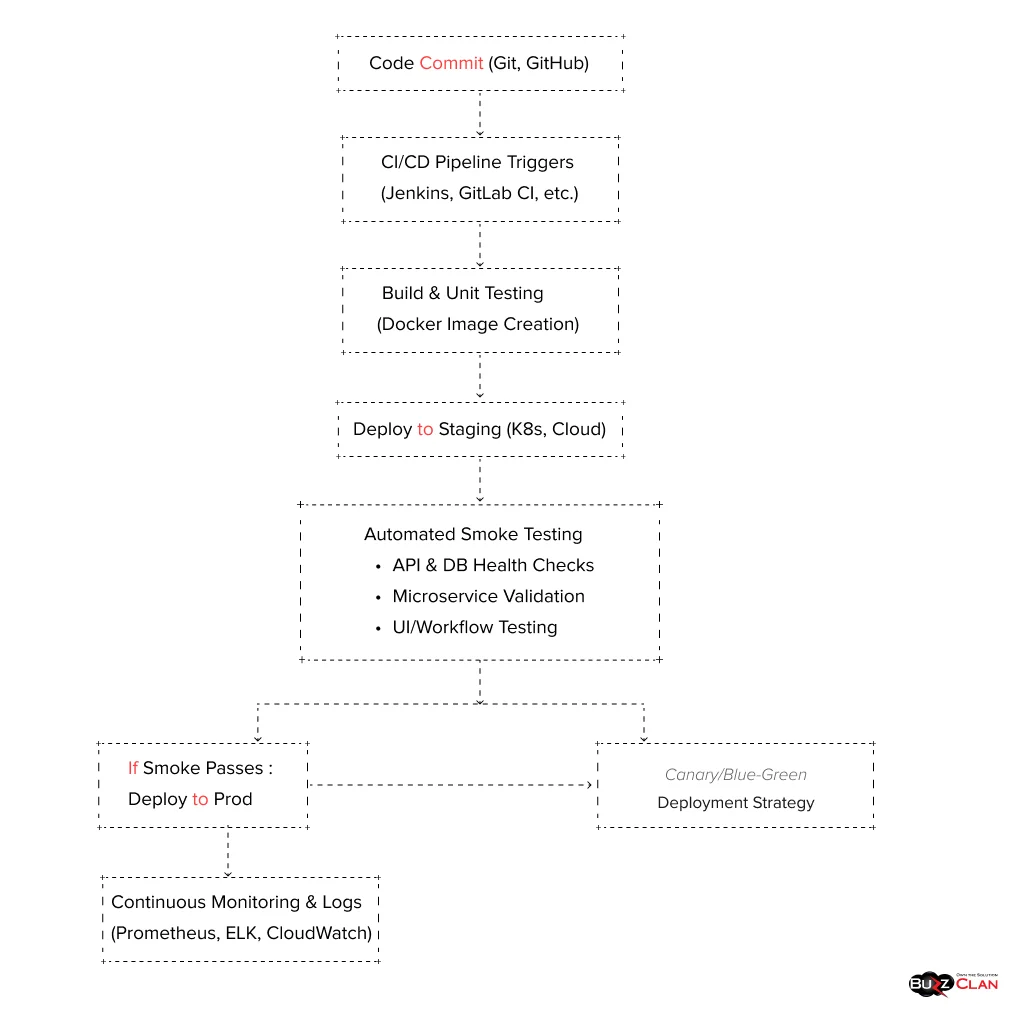
Dealing with DevOps-driven workflows means that smoke tests are embedded in (CI/CD) pipelines. One of the approaches to smoothly run tests in these environments is the shift-left approach, where automated smoke tests run in the earliest stages of development. Another approach uses progressive deployment strategies. Only a few users receive the new version, and automated smoke tests monitor them for errors. If the test passes, further action is taken. Otherwise, an instant rollback is initiated. Often, developers and testers integrate observability tools to ensure all the smoke test failures are accounted for and debugged efficiently.
Best Practices for Smoke Testing
Here are some practices that will help you boost the efficiency and reliability of your smoke tests.
Manual tests can lead to multiple errors. So, it is essential to use automated test tools to validate core functionalities.
- Make sure you are not expecting a lot from your smoke tests. The focus should always be on checking the key features. Overloading them will only defeat their purpose.
- You must run tests after every application version to be 10x sure that your core functionalities work just fine.
- Documentation is the key to success and is also used for smoke testing. Maintaining a list of test cases and results can avoid common pitfalls and save time for other application versions.
- Stop wasting your time on repetitive tasks and instead use automation to save time and eliminate human errors.
- Conducting smoke tests in random environments is not beneficial. They should be run in environments that resemble production.
- Make sure to partner with analysts, testers, and developers to be thorough with critical aspects of smoke testing.
- While you may run your tests using virtual machines, containers, or cloud environments, consistency is the key to results.
- Run your smoke tests using continuous integration (CI) and continuous deployment (CD) pipelines to validate all builds.
- Smoke tests will occasionally fail. However, you must maintain clear logs and reports to identify issues efficiently.
- Last but not least, review test cases to ensure they are relevant as technology evolves.
Smoke Testing Configuration for Popular CI/CD Tools
Let’s see how you can integrate smoke testing into CI/CD pipelines with sample configurations.
Jenkins
pipeline {
agent any
stages {
stage('Build') {
steps {
sh 'mvn clean package'
}
}
stage('Smoke Test') {
steps{
sh 'pytest tests/smoke_tests.py'
}
}
}
post {
failure {
echo 'Smoke Test Failed! Stopping Pipeline...'
error('Build failed due to smoke test failure')
}
}
}
GitHub Actions
name: Smoke Test Workflow
on: [push, pull_request]
jobs:
smoke-test:
runs-on: ubuntu-latest
steps:
- name: Checkout code
uses: actions/checkout@v3
- name: Set up Python
uses: actions/setup-python@v4
with:
python-version: '3.9'
- name: Install dependencies
run: pip install -r requirements.txt
- name: Run Smoke Tests
run: pytest tests/smoke_tests.py
GitLab CI/CD
stages:
- build
- smoke_test
smoke_test:
stage: smoke_test
script:
- pytest tests/smoke_tests.py
allow_failure: false
Error Handling Patterns in Smoke Testing
Handling failures is a must with smoke testing.
- You can easily capture logs, generate detailed reports with frameworks like pytest or JUnit, and ensure easier debugging.
import logging
logging.basicConfig(level=logging.INFO)
def test_login():
logging.info("Starting login smoke test...")
response = requests.post("https://example.com/api/login", json={"user": "test", "pass": "123"})
if response.status_code != 200:
logging.error("Login test failed!")
raise AssertionError("Smoke Test Failed: Login API issue")
- If the test intermittently fails, you can retry it a few times before failing the build.
import requests
import time
def retry_request(url, retries=3, delay=2):
for _ in range(retries):
response = requests.get(url)
if response.status_code == 200:
return response
time.sleep(delay)
raise Exception("Smoke Test Failed: API is not responding")
def test_health_check():
response = retry_request("https://example.com/api/health")
assert response.status_code == 200
- If a smoke test fails, CI/CD pipelines should stop further stages and notify teams.
notify_failure:
if: failure()
script:
- curl -X POST -H 'Content-type: application/json' --data '{"text":"Smoke Test Failed! Check logs."}' $SLACK_WEBHOOK_URL
ROI Calculations for Smoke Testing with Metrics and KPIs
While you know the benefits of smoke testing, have you thought about how you can calculate its ROI? Well, here is the formula and steps you need to take:
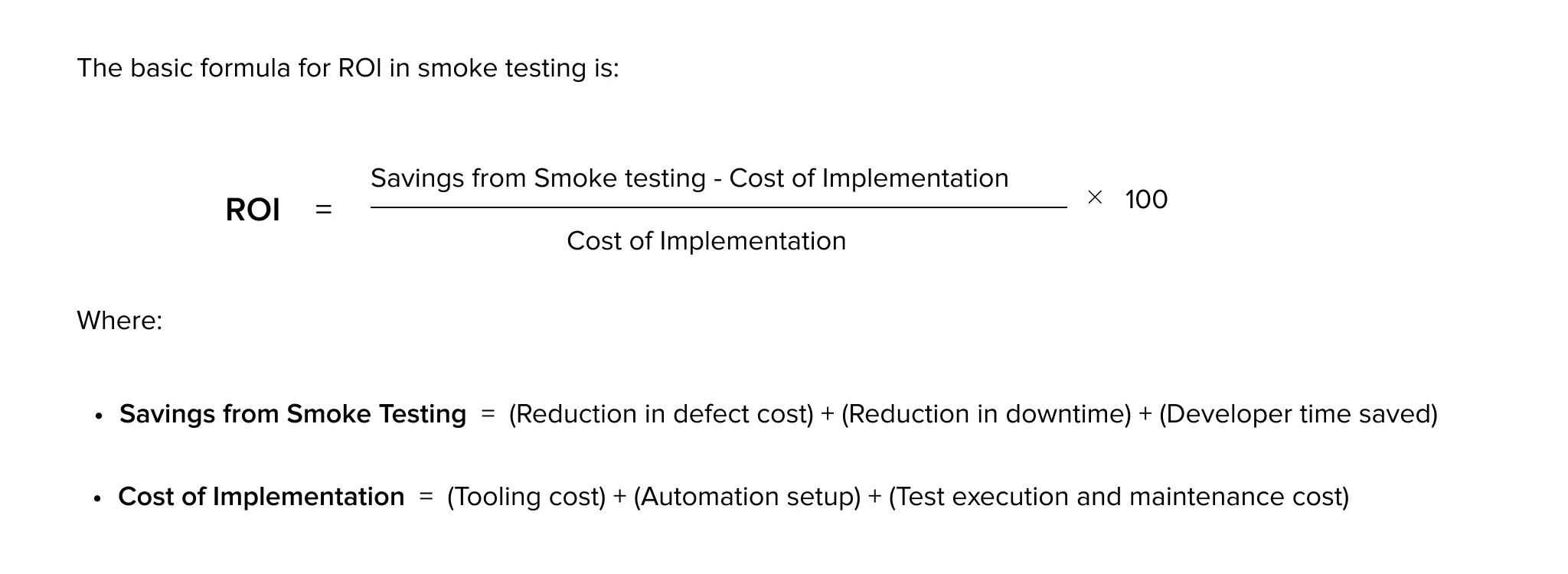
Key Metrics and KPIs for Measuring ROI
Here are some of the metrics you need to know.
- Defect Cost Reduction
Here is the formula for calculating defect cost reduction.
Cost Reduction = (Avg. Cost per Defect x Defects Caught Early) – Late-stage Fix Cost
Let’s say the average cost you need to fix a defect in production equals $5000
At the same time, fixing it in the earlier stages cost $500.
Even if smoke tests catch 50 such defects annually, you will be able to save:
(50×5000)−(50×500)=250,000−25,000= $225,000
- Reduction in Deployment Failures
KPI: % of deployments that pass smoke tests without rollback
Let’s say if each rollback costs $10,000, and the percentage is reduced from 20% to 5%, the annual savings for all such deployments would come down to:
(20−5)×100×10,000= $150,000
- Time Saved per Developer
KPI: Hours saved in debugging and fixing production issues
Your developers may not have all the time in the world. Thus, it is essential to carry out smoke tests precisely.
If smoke testing reduces debugging time by 10 hours per developer per month and you have 10 developers who are earning $50/hour, the savings per year would be:
10×10×50×12= $60,000
- Faster Release Cycles
KPI: Reduction in time spent on manual verification
Yes, automated tests can help you cut time and errors in manual smoke testing.
Let’s say if automated smoke tests cut 2 hours from each release cycle, and there are 50 releases per year, with a $100/hr team cost. Here is how much you can save annually.
2×50×100= $10,000
- Customer Satisfaction & SLA Compliance
KPI: % reduction in post-release defects reported by customers
If customer-reported defects drop by 30%, leading to $50,000 fewer SLA violation penalties, your ROI will also increase.
Now that we have all figures, let’s look at the total calculations.
Total ROI Calculation
| Category | Annual Savings |
|---|---|
| Defect cost reduction | $225,000 |
| Reduction in rollbacks | $150,000 |
| Developer time saved | $60,000 |
| Faster release cycles | $10,000 |
| SLA compliance improvements | $50,000 |
| Total Savings | $495,000 |
| Implementation Cost | $100,000 |
| ROI | 395% |
This means you can easily save $3.95 for every $1 spent. In the long run, you can look forward to improved software quality, long-term cost savings, and reduced failures.
Smoke Testing in Large-Scale Implementations
Smoke testing can help you prevent failures when implemented in enterprise environments. Similar is the case with Amazon Web Services (AWS). Whenever multiple deployments are made across various regions, automated smoke tests check the system’s health before the final rollout. So, how does AWS manage all this? Well, it is done with canary deployments. In this arrangement, a few servers receive the update, and then automated smoke tests are conducted on critical workflows, database connections, and API health. If the system’s health is sound, the update is expanded gradually.
Another example is that of Netflix. It follows a microservices architecture to run containerized smoke tests in parallel across different clusters. Smoke tests validate whether streaming, user authentication, and recommendations work properly before full deployment.
Compliance and Regulatory Considerations in Smoke Testing
We all know that industries like healthcare and telecommunications must abide by strict compliance rules. However, these rules can impact the efficiency of smoke testing processes. Banks and fintech institutions must adhere to PCI-DSS (Payment Card Industry Data Security Standard), so smoke tests must ensure that encryption protocols, API security, and authentication mechanisms also work. In the worst-case scenario, if the test fails, there must be provisions for immediate rollback and audit logging to maintain compliance. Also, regarding healthcare, compliance with HIPAA (Health Insurance Portability and Accountability Act) in the U.S. and GDPR (General Data Protection Regulation) in Europe is necessary. And how do smoke tests help with the same? They allow you to maintain vigorous access controls and ensure compliance with data-sharing regulations.
Smoke Testing Vs. Regression Testing
Let’s understand the differences between the two approaches of testing software.
| Parameter | Smoke Testing | Regression Testing |
|---|---|---|
| When is it performed? | These tests are conducted after a new build or a significant update. | After bug fixes, updates, or new features are implemented, regression testing is done. |
| Scope | The scope is narrow as it only focuses on the basics. | The scope is broad as it includes all areas affected by the changes. |
| Time Taken | A short time is needed to execute these tests. | Regression testing is time-intensive as multiple test cases need to be executed. |
| Automated or Manual | It can be manual or automated. | Mostly automated due to a more enormous scope and errors in manual testing. |
| Outcome | A simple pass or fail. | Detailed test reports are generated to confirm if existing features are intact. |
| Examples | Ensure the login page loads successfully. | Verify if the login page works smoothly when adding a new feature to the registration page. |
Tools Used for Smoke Testing
While you may choose to conduct your smoke tests manually, these tools will make your job easier.
Selenium
If you want a popular tool to automate your smoke tests, consider it complete with Selenium. It is a standard favorite of developers and testers as it allows excellent cross-browser and cross-platform compatibility. And the benefits don’t end there! Selenium also provides extensive support for automation frameworks. However, it has a drawback because it requires some programming and set-up time.
TestNG
An ally to Selenium, TestNG is beneficial for Java applications. It is an ideal tool because it lets you easily group and prioritize tests. Moreover, you can conduct parallel tests and generate detailed reports to understand defects better. However, you will need to acquire programming skills related to Java to put this tool to the best use.
Appium
Designed for mobile apps, Appium will help you with hybrid, native, and web apps. Moreover, you get access to cross-platform capability only with a single codebase. Wait, there is more to it! Appium integrates well with CI/CD tools. The only drawback is that it is slower than other tools.
Jenkins
The best part about Jenkins is that it can integrate seamlessly with multiple testing frameworks and automate smoke tests. You can look forward to comprehensive testing and reporting logs with multiple support plugins. This is the reason why many software developers have unbreakable trust in Jenkins. However, you must shell out time to set up the tool.
AutoIt
AutoIt could be your pick if you are building a Windows desktop application. It makes writing scripts for basic UI actions easy and requires minimal setup. This application’s only limitation is that it caters to Windows applications.
Smoke Testing vs Sanity Testing
Let’s understand the key differences between smoke testing and sanity testing.
| Parameter | Smoke Testing | Sanity Testing |
|---|---|---|
| Execution | It is executed after a new build is released to check for basic functionality. | To confirm its integrity, sanity testing is conducted after minor code changes or bug fixes. |
| Scope | It covers all the significant features of the application. | The scope is narrow as limited areas are tested. |
| Automation | Smoke testing can easily be automated. | It is performed with manual methods as it requires focused verification. |
| Time taken | It is not time-consuming and only takes a short time. | It is faster than smoke testing as it focuses on super-specific areas. |
| Example | For a banking app, check if login, fund transfer, and balance inquiry are functional. | Verify if an issue with transaction history filtering is resolved. |
Smoke Testing in Different Software Development Models
While each model’s basics are the same, their approach is different. Some models suggest frequent and automated testing, while others suggest manual methods for specific instances.
Waterfall Model
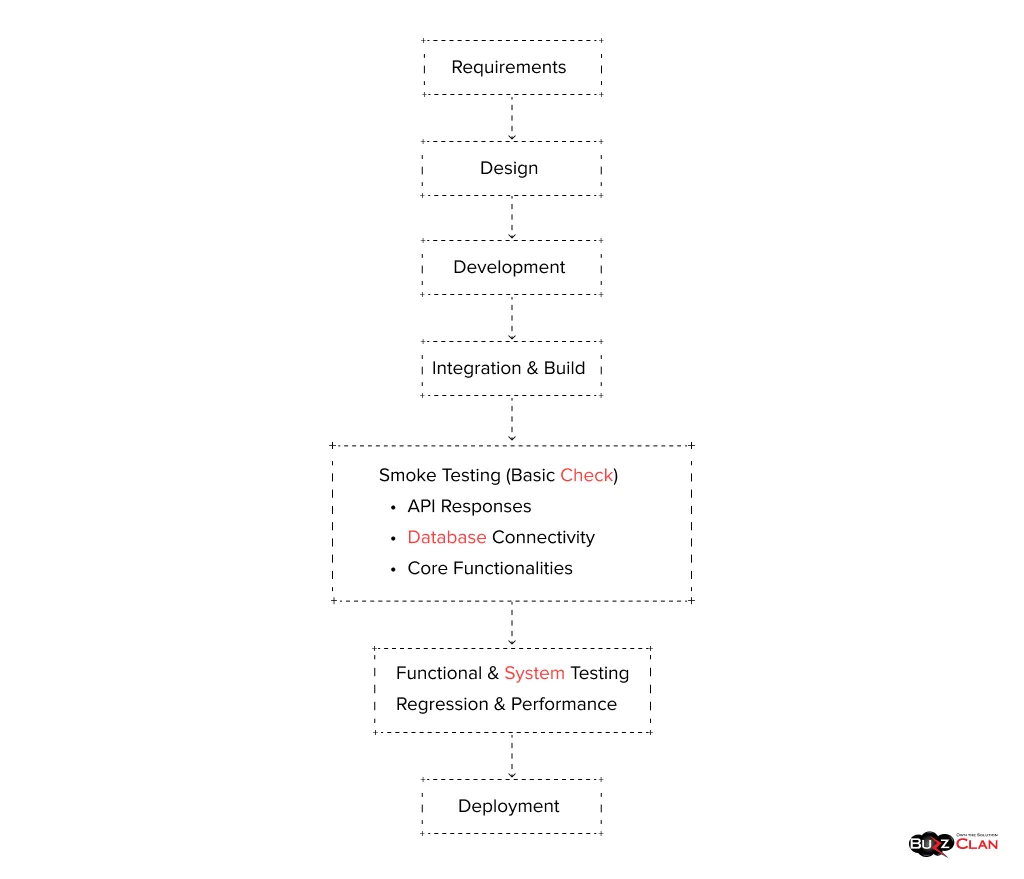
- Smoke Testing in Waterfall Model: This model has been designed with stable software needs in mind. Each phase must be completed before proceeding to the next. As a result, a smoke test is conducted at the beginning of the test phase and the post-development phase. This is a blessing in disguise for testers, as it saves them a lot of time and ensures that all modules function smoothly at the basic level.
Agile Model
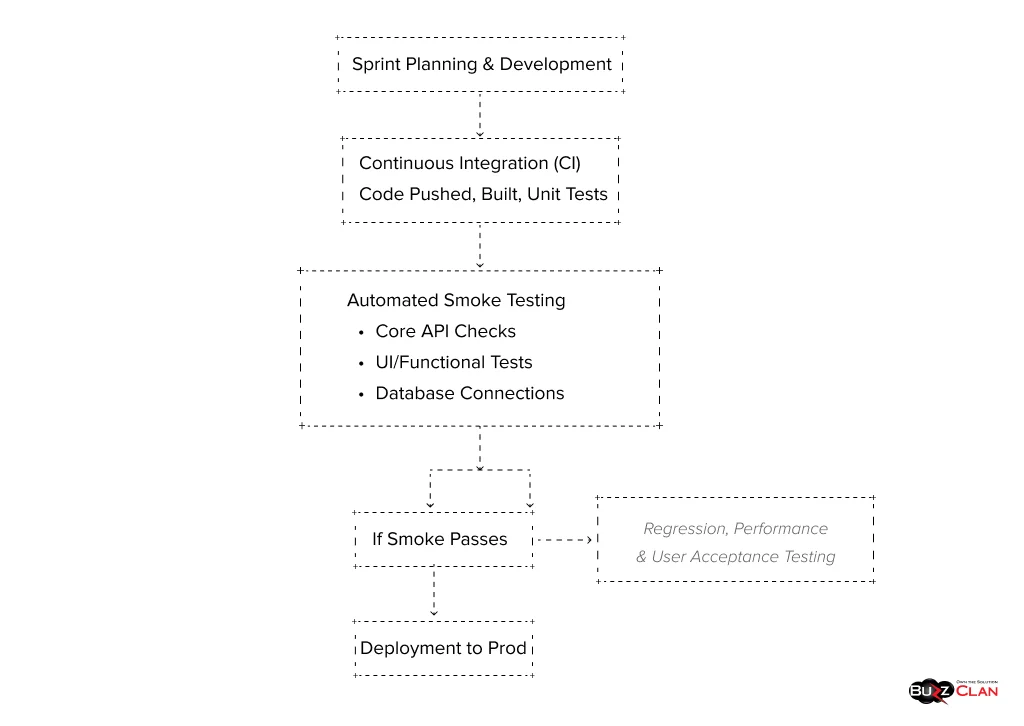
- Smoke Testing in Agile Model: Developers prefer this model because they get quick feedback on application defects. How is that helpful? It helps them keep the iteration process smooth. In this model, smoke tests are conducted at the start of each sprint after the build is created. This, in turn, helps ensure that new features work in sync with the existing ones.
DevOps Model

- Smoke Testing in DevOps Model: This model emphasizes facilitating collaboration between development and operations teams. Thus, you can easily integrate automated smoke tests into CI/CD pipelines and ensure that only stable application versions undergo rigorous tests. Another benefit of using this model is that it helps you reduce downtime and helps your team prioritize their tasks.
Incremental Model
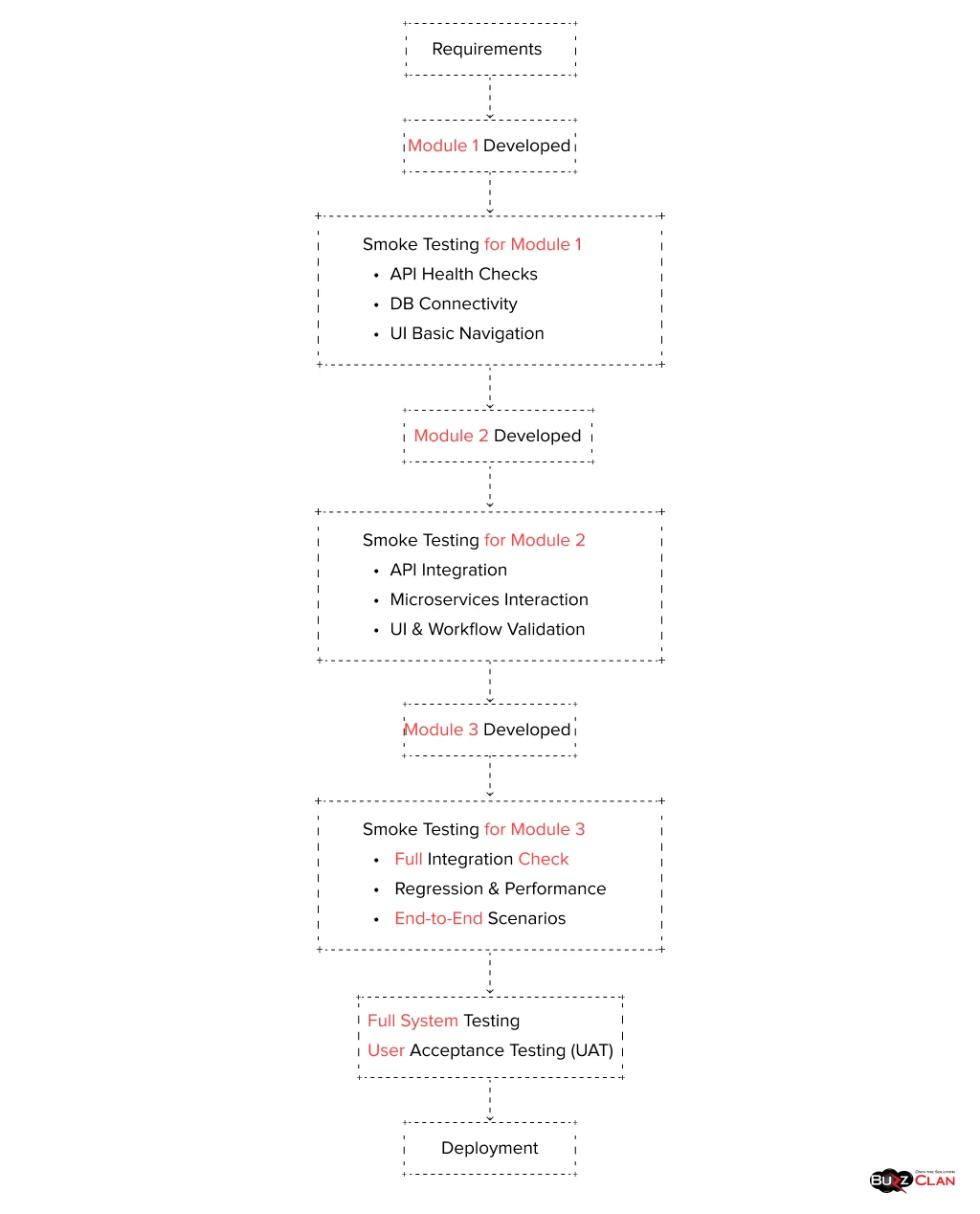
- Smoke Testing in Incremental Model: Conducted in stages, this model involves conducting tests after each increment. This ensures that new changes do not break the established system. And how does this benefit your application? It lets you quickly provide the smooth integration of new functionalities and develop confidence in your application.
RAD (Rapid Application Development) Model
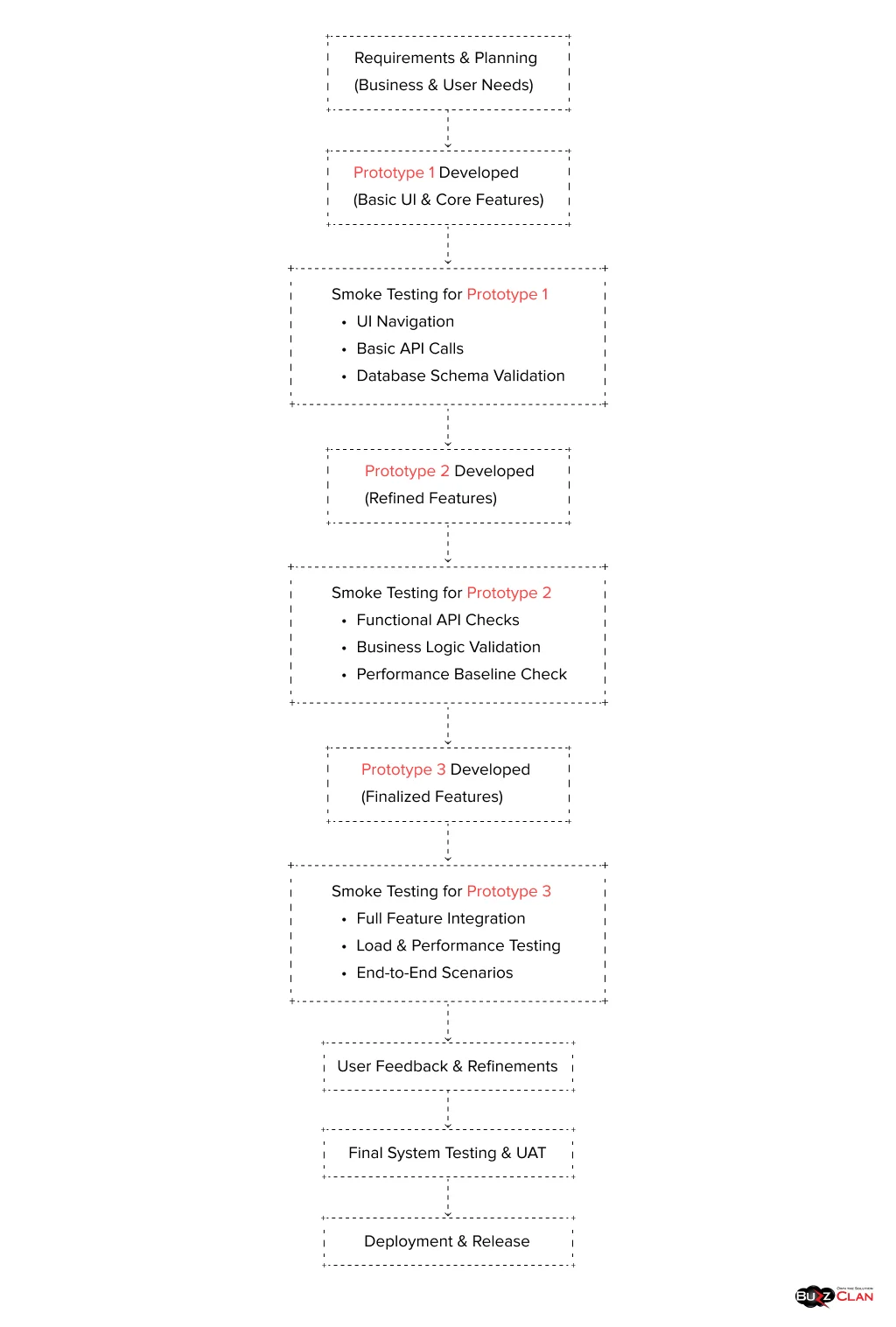
- Smoke Testing in RAD Model: As the name suggests, this model focuses on rapid prototyping and iterative development. By conducting tests efficiently, quickly, and flexibly, you can be twice as sure of your build quality. Another reason to use this model is that it will prevent a lot of rework, as you will address issues earlier.
How Companies Can Implement Smoke Testing to Drive Growth?
When it comes to building software, reliability and profitability are of paramount importance. Smoke testing helps you achieve that and much more. Here is how you can implement it to boost growth.
Saves Time and Resources
Time and resources are the backbone of any business. There is no point in testing an application to find out the major features don’t work and that you need to redo everything. Smoke testing catches major issues early and helps you focus your efforts and time on core business processes.
Enhances Product Quality
A higher standard for software builds becomes a regular thing with smoke testing. You can build a better reputation in the market and look forward to increasing your prices and offering better benefits to your employees and customers.
Boosts Team Morale
Doing the same work again leads to frustration and poor spirits in your QA teams. Luckily, you can avoid this situation with smoke tests. It ensures that QA teams only work on reliable application versions and builds a conducive environment.
Reduces Downtime
A study suggested that 98% of companies reported that a single downtime hour costs over $100,000; for some, it can go up to $1 million per hour. If you want to cut these losses and ensure that your solutions are free of bugs and zero outages, make smoke testing your best ally. Not only will it help you eliminate such incidents, but it will also help you build a solid business reputation.
Boosts Productivity
It is productive work that yields high ROIs. Without smoke testing, testers waste time on issues caused by fundamental defects. However, when you conduct these tests, you ensure only stable builds go forward for deeper tests. This way, you save time for developers, and they can use it for better pursuits.
Wrapping Up
Smoke testing in software testing improves quality and stability verification and saves time and resources. Addressing the discussed aspects can streamline your application development process. Also, when you know that the software quality is top-notch, you can look forward to expanding your service across industries and seeing a significant increase in your revenue margins.
As word of mouth spreads, your clientele will increase, and you can look forward to working with global clients and expanding your technology portfolio. BuzzClan provides top-notch QA support and tools to help you achieve all this and much more, fulfilling your business goals without compromising quality and operational excellence.
FAQs

Get In Touch
